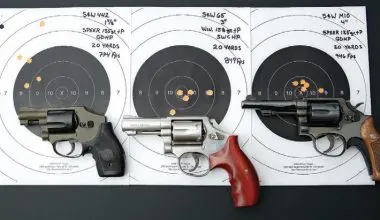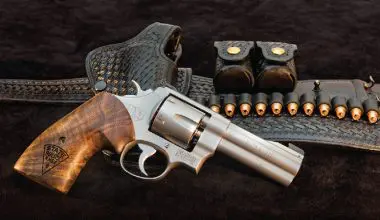
Over the years, we’ve seen extensive evolution with regard to the rifle industry, but we haven’t seen proportionate improvements within the pistol industry. There have been advancements on some fronts, but nothing earth-shattering since the introduction of the Glock platform. Sighting systems on pistols remained largely the same.
A few manufacturers produced novel concepts that helped increase the acquisition and viewability of the front sight. Some proved valuable, but most came up short until the advent of mini red dot sights (MRDS). These sight systems originated within the competition arena and laid a good foundation for what we see on the market today. The use of MRDS systems gives the end-user tremendous advantages in the form of any-time viewability and increased accuracy and consistency.
One of the big differences between competition-equipped pistols and duty-driven pistols is that competition pistols had the sights mounted to the frames. This meant faster target acquisition since the sight system wasn’t reciprocating with the slide.
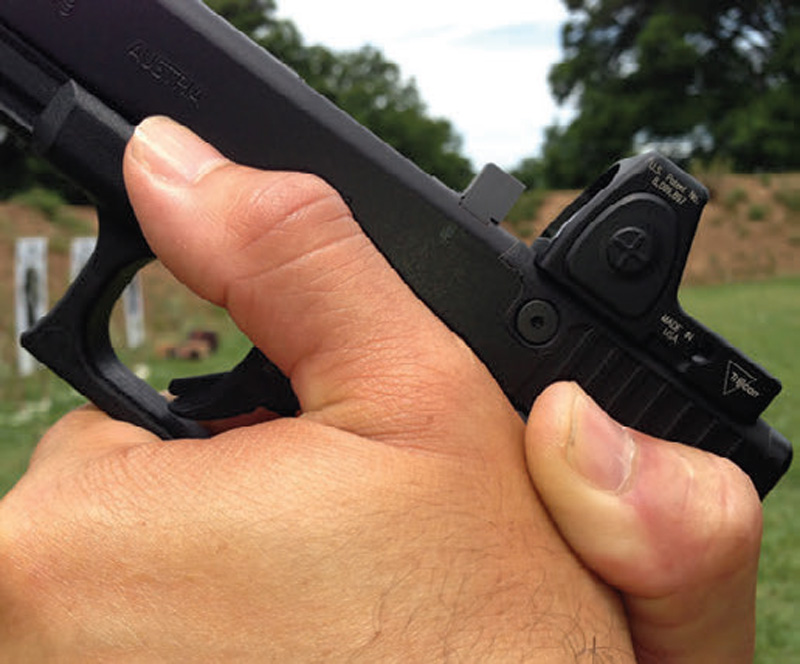
But the problem with this configuration is that they are more expensive, bulkier and lack the supporting equipment such as duty holsters. Slidemounted sight systems give the enduser a smaller, more robust package, along with a broader range of supporting equipment.
What is all the fuss about mini red dot sights?
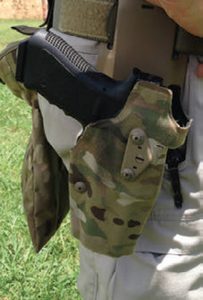
As the old saying goes, we are not getting any younger, and some of us are struggling in the eye department. As our eyes become more seasoned, it becomes more and more difficult to fixate on the front sight at arm’s reach. A likely reason is presbyopia, a condition in which age causes the eye to be less able to focus on near objects. Additionally, more and more people are developing eye problems at a younger age, likely caused by staring at a computer screen for long periods of time.
Table of Contents
ADVANTAGES OF MRDS
There are three major advantages to using a mini red dot sight. First, it allows you to track the target and thereby avoid transitioning your focus from the target to the front sight when using traditional iron sights.
Second, an MRDS is designed to be used with both eyes open, allowing for binocular vision. Keeping both eyes open provides several advantages on the battlefield, such as improved visual acuity, expanded peripheral vision, depth perception, and eye motility (the eye’s ability to track moving targets).
Third, the most popular color for MRDS reticles is red, which gives great anytime viewability against a variety of lighting conditions and contrast against a variety of backstops.
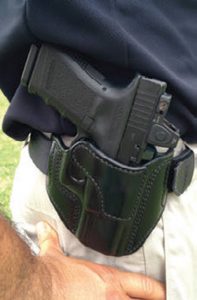
My interest in mini red dot sights began when a teammate contacted me as he was researching possible solutions to a tactical problem. As a lead climber, he was often put in compromising positions where access to his rifle was severely limited, and he frequently defaulted to his pistol. Since the majority of his operational conditions were at night, he was under night-vision devices, which meant he had virtually no means to see his iron sights. He had tried various laser options, but none of them fulfilled his mission needs.
I set out to research new laser options and realized that the better solution was to employ an MRDS. At the time there weren’t many available, but the concept certainly showed merit. Once we were able to find suitable night-vision-compatible packages, it became extremely reliable, while increasing the end-user’s survivability through increased accuracy and range.
While the average person may never need to utilize this technology in conjunction with night vision, they will reap huge benefits from the MRDS by itself.


LEUPOLD DELTAPOINT AND TRIJICON RMR
There are several types of mini red dot sights available on the market, but some are more suited to competition than duty use. During the testing and evaluation phase, I concentrated on units from the two most popular manufacturers— the Leupold DeltaPoint and Trijicon RMR. Each of these sights provides increased performance, with some limitations. The fact that each sight provides increased viewability in a small, robust package makes them viable contenders.
Each of the sights has models that automatically adjust the reticle’s intensity according to the ambient lighting conditions. Both are on equal footing as far as sensitivity to light and speed of adjustment are concerned. While we lack a laboratory in which to conduct more extensive testing, I am confident that the average person will find them to adjust quite well.
Both systems have a problem with wash-out during low-light conditions: the intensity adjusts accordingly, but when the end-user employs a white light, the red dot becomes almost transparent.
Battery life for the DeltaPoint averaged about 300 hours of continuous use. If the pistol were carried on an eight-hour shift, that would be roughly 30 days of straight use. It is advisable that a battery replacement cycle be incorporated to ensure a fresh battery is maintained for duty-type use.
The RMR has surpassed the 1,000- hour mark in our evaluation and shows no sign of decreased intensity. Manufacturer information describes a lifetime of 4,000 hours at brightness setting four (out of eight).
Another problem with both is the requirement to remove the housing in order to replace the battery. The concern was whether the optic would return to zero, but in evaluation I found minimal shift to point of impact (POI).
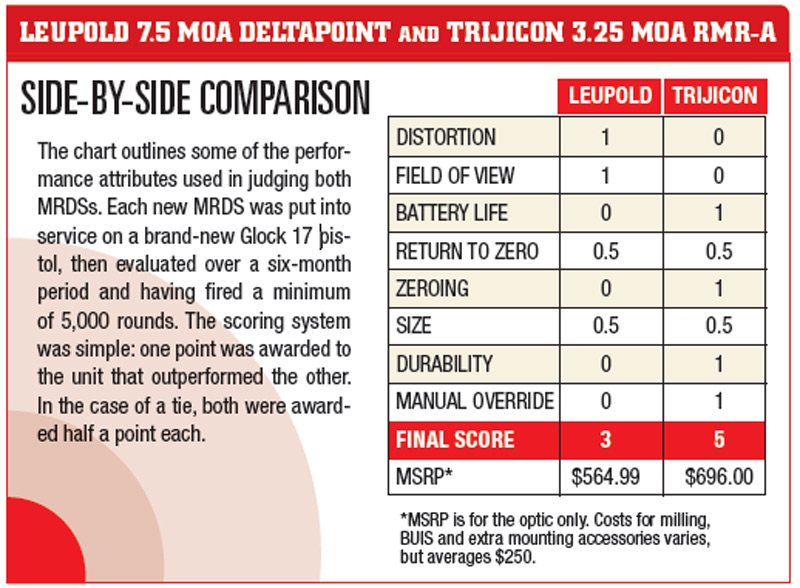
The DeltaPoint scores high with clear and distortion-free glass, along with a larger field of view. The RMR scores high with a more rugged metal housing that increases its durability, as well as much longer battery life compared to the DeltaPoint. Some models of the RMR have an adjustable LED feature, which allows the unit to be powered off or the dot’s intensity adjusted. This gives it a higher score overall. While some units have demonstrated electronic failures, the manufacturer is working to remedy the problem.
OPTIC-PISTOL INTERFACE
There are three options for interfacing between the pistol and the optic. The first option is replacing the rear sight with an adapter plate that is secured in the rear sight notch. Not only do you lose your backup iron sights, but the optic is placed much higher, causing sight acquisition complications. The first choice is not recommended.
The second option is to have the slide permanently milled to accommodate and secure the specific optic. The third option is to have the slide milled to accommodate the Unity Tactical ATOM Mount. The ATOM Mount provides the most versatility, with interchangeable mounting plates that allow the end-user to switch between the most common mini red dot sights.
BUIS AND REAR SIGHTS
Regardless of the mini red dot sight selection, backup iron sights (BUIS) should be mandatory for any serious duty or carry pistol. In order for the BUIS to be co-witnessed with the mini red dot sight, taller/suppressor-height sights are necessary.
The taller sights will place the sight alignment in the lower portion of the field of view, so the end-user can rapidly transition to his BUIS in case of optic failure.
There are two options for rear sight placement: either place the rear sight in front of or behind the mini red dot. Advantages of placing the rear sight in front of the mini red dot include achieving protection for the front portion of the glass and housing, aligning both iron sights in the same plane with regard to distortion seen through the glass, and reducing modification to supporting equipment such as holsters.

ZEROING
Whichever optic you select, you will have to zero that optic to take advantage of all the benefits. A 25-yard zero is recommended, with a flat enough trajectory to effectively engage targets from 0 to 100 yards.
The RMR scored higher than the DeltaPoint due to ease of zeroing. Those familiar with zeroing red dot sights on rifles will appreciate zeroing the RMR, which gives positive audible and tactile clicks and does not require any special tools to make adjustments.
The DeltaPoint requires a mini Torx head wrench and has no audible or tactile registration of movement. Zeroing the DeltaPoint requires more patience and a bracketing method. One perceived advantage of the DeltaPoint was the ability to lock the sight adjustments using the mini Torx head wrench.
HOLSTERS
One complication regarding mini red dot sights is the lack of supporting equipment in the form of holsters. For those looking to carry an MRDSequipped pistol on duty, the best holster is the Safariland 6354DO ALS holster. This holster is currently only available for Glock models, both with and without weapon-mounted lights, and in Multicam© or FDE color patterns only.
The ALS retention system is handsdown the best on the market today. The hard plastic shell of the holster has extended sides that protect the mini red dot while in the holster. For those wishing to carry concealed or off-duty, there are several options to consider.
There are a couple of leather and several Kydex® holster manufacturers doing good work. I am working with a couple to fine-tune their products and make them more readily available to the general public.
RETICLE
Once you have decided to employ an MRDS, another consideration is the type and size of the reticle. The RMR uses a dot and the DeltaPoint, as the name implies, uses a triangle reticle.
With regard to the dot size, the two most popular sizes are a 3.5 MOA and a 6.5 MOA dot. The smaller dot size theoretically provides increased accuracy, but there is a trade-off in that the increased accuracy will really only be noticeable at extended ranges of 25 yards and greater. By comparison, the larger dot should give less accuracy at extended ranges, but quicker acquisition at closer ranges.
The truth is, I find both of these conditions to be very subjective and user specific. When shooting at the 25-yard line, both dots showed increased accuracy over iron sights. However, if given the opportunity to benchrest each pistol, I’m sure the smaller dot size would prove more accurate. At close range and depending on the lighting conditions, I found the larger dot somewhat more quickly, but it was difficult to see the consistency in my baseline times.
I have chosen to equip my duty pistol with the smaller dot and my carry pistol with the larger dot, on the assumption that my duty engagements would potentially have extended ranges and carry engagements would typically be close range. Your mileage may vary, but that’s what I observed throughout the evaluation process.
The interesting comparison was not so much the size of the dot, but a dot versus a delta. I found the 7.5 MOA delta to show interesting performance both at close and extended ranges. At closer ranges, superimposing the triangle’s mass produced quick and accurate shots on target. At extended ranges, using the tip of the triangle produced the most accurate of shot groups among all types and size reticles.
CONCLUSIONS
While MRDSs are not perfect, they are an improvement over traditional iron sights. As users’ eyesight worsens, it will become more and more challenging to focus on the front sight.
The MRDS can step in and fill the gap by giving end-users the ability to stay focused on the target and not on the dot/iron sight. Because it favors binocular vision, it will allow for greater situational awareness on the battlefield. The red dot will increase the viewability through a variety of lighting conditions and backgrounds, thereby increasing hit potential.
The by-products of these advantages equate to greater accuracy and more consistent speed over a broader operational environment, even as users’ near vision decreases.



